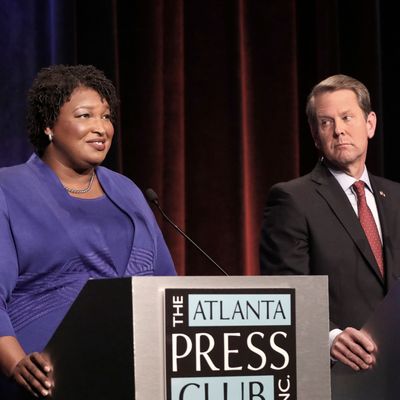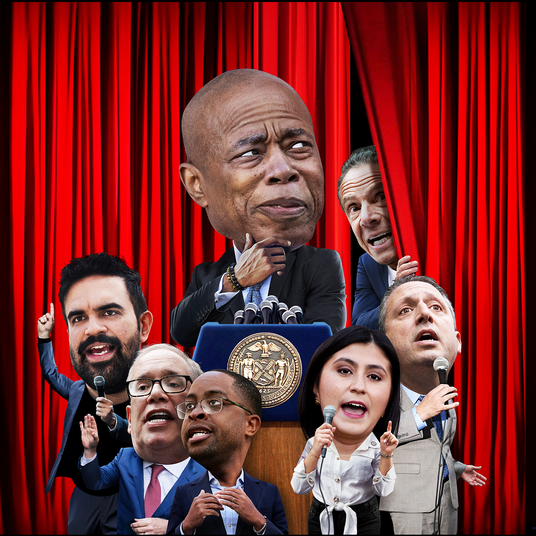
The big 2021 political story, aside from efforts to end and recover from the COVID-19 pandemic, is a guerrilla war over voting rights. Across the country, drawing inspiration from Donald Trump’s lies about voter fraud, Republican-controlled legislatures are battling to restrict the franchise in ways almost too numerous to count (though the Brennan Center for Justice is trying to keep up).
It’s no accident that some of the most intense voter-suppression activity is in states narrowly carried by Joe Biden in 2020 but where Republicans hold a governing trifecta, namely Arizona and Georgia. In these two states they are entirely able to enact voting restrictions with Democrats left howling on the outside. If the GOP can overcome its own divisions, and not write laws so stupidly that the courts will strike them down, they can perhaps hold off or reverse blue trends simply by shrinking the electorate. Or so they hope. They also hope to head off Democratic efforts to preempt state voter suppression activity via a restored Voting Rights Act or the much more definitive legislation already passed by the U.S. House in H.R. 1, the For the People Act (both likely doomed in the Senate unless there is filibuster reform).
At the same time, Republican-controlled legislatures and governors will seek to use their power to exploit the decennial redistricting process and tilt the scales even further in their direction in future U.S. House and state legislative contests. Two highly contested states with Republican-controlled legislatures, Arizona and Michigan, have independent commissions that play a key role in redistricting. But in Georgia, and reasonably competitive Florida and New Hampshire, redistricting is an all-Republican show. Add in the historical phenomenon that midterm elections tend to produce wind beneath the sails of the party that does not control the White House, and you can see that 2022 could be a pretty good Republican year nationally, especially if voting restrictions are adopted widely.
But the future of voting rights, and in turn of the partisan balance, in many states will be on the ballot in 2022 as well. There are a number of highly competitive states where a Democratic governor is the only thing standing between Republicans and further screwing around with the franchise, such as Michigan, North Carolina, Pennsylvania, and Wisconsin. Since state legislatures tend to shift ground more slowly than governorships (particularly in the first year after redistricting, which usually solidifies incumbents), 2022 gubernatorial races could represent a huge battle that will both reflect and intensify the fight over who gets to vote and how, along with a vast array of other policy issues dividing the two major parties. Let’s look at a few examples:
Georgia: Ground Zero for the Battle Over Ballots
Georgia’s GOP legislature is on the brink of passing an assortment of new voting restrictions limited only by their internal divisions over the best way to make voting harder for Democrats (which in Georgia means harder for Black voters) without discommoding their own voters. But the battle will bleed quickly over into the 2022 gubernatorial race, which is expected to be a rematch (and most definitely a grudge match) between Democrat Stacey Abrams and Republican incumbent Brian Kemp. There aren’t just any two pols; they are both most prominently known for diametrically opposed positions on voting rights. Abrams’s entire career has been devoted to the task of registering and mobilizing disenfranchised groups of voters, particularly minority voters. And Kemp’s claim to fame when he ran for governor in 2018 was his record as a shrewd and successful vote suppressor who refused to give up his control as secretary of State over election machinery despite the blatant conflict of interest that involved. There’s not much question that Kemp’s tight and unfriendly grip on the voter rolls made the crucial difference in his narrow win over Abrams.
Abrams, the unquestioned leader of her party in Georgia, passed up the opportunity to run for the Senate in 2020 (when she would have almost certainly have won, given the January runoff victories of both Jon Ossoff and Raphael Warnock), presumably because she craves another chance to take down Kemp. And whatever help Kemp gets from either the voting restrictions under development right now, or a helpful midterm environment, could be neutralized by a credible primary challenge fed by Trump’s fury with him for his certification of Biden’s 2020 victory. Close Trump ally and unsuccessful 2020 Senate candidate Doug Collins is mulling a challenge to Kemp at the 45th president’s urging. Even if Collins demurs or decides to run for the Senate again, in a state full of ambitious Trump fans it’s hard to imagine Kemp will escape a primary challenge altogether. But no matter who winds up facing Abrams, voting rights will most definitely be front and center in the campaign, and the results should be close and consequential. It’s worth remembering again that Georgia requires general election runoffs if no one wins a majority in November, so another expensive and savage overtime campaign in the Peach State is a distinct possibility.
Arizona: A Post-Ducey Scramble
Arizona has rivaled Georgia in the plethora of voting restrictions Republican legislators have embraced, with nearly two dozen bills having been introduced this year, including some restricting voting by mail and others beefing up voter-ID requirements. But like its counterpart in Georgia, Arizona’s GOP is bitterly divided. One major object of Trumpist wrath in the state, Governor Doug Ducey is term-limited. While the 2022 gubernatorial field is forming slowly, Democrats have several strong possibilities, including Secretary of State Katie Hobbs and Phoenix mayor Kate Gallego. Among Republicans, one of several right-wing U.S. House members could try to return to Phoenix, including House Freedom Caucus chairman Andy Biggs and Dave Schweikert, and Attorney General Mark Brnovich appears to be appealing to conservative voters via border-security alarms. More moderate options are State Treasurer Kimberly Yee and former Ducey chief of staff (and former House speaker) Kirk Adams.
Despite Arizona’s purple political status, Democrats haven’t won a gubernatorial election there since 2006, when Janet Napolitano secured a second term.
Pennsylvania: A Mix of Geography and Ideology
In Pennsylvania, Democratic governor Tom Wolf is an obstacle to GOP voter-suppression plans, which hasn’t kept Republican legislators from introducing bills to eliminate no-excuse voting by mail and add onerous new signature verification requirements. If they could replace the term-limited Wolf with one of their own, voter suppression efforts might succeed.
Pennsylvania is also another state where an open Senate seat will beckon some ambitious pols; Lieutenant Governor John Fetterman is running for the seat Republican Pat Toomey is giving up. Attorney General Josh Shapiro is considered the early Democratic front-runner, though it could get interesting if Philadelphia mayor Jim Kenney decided to run. Another possibility is long-time officeholder and diplomat Joe Torsella, who was upset in his reelection bid as Treasurer in 2020. All three of these men are from southeastern Pennsylvania, which could tempt candidates from other parts of the state into the contest.
As in many states, Pennsylvania’s Republicans have divisions over loyalty to Trump. One very Trumpy local official, Montgomery County Commission Joe Gale, is already in the gubernatorial race, where he could be joined by national MAGA favorite and congressman Mike Kelly, who may have an advantage as someone from western Pennsylvania. Still another Trump-adjacent possibility is state senator Doug Mastriano from central Pennsylvania, who has the distinction of testing positive for COVID-19 after chairing a mostly maskless post-election legislative hearing to air Rudy Giuliani’s insane election-fraud theories. There are an array of less divisive state legislators also looking at the race, which will likely revolve around the usual Keystone State mix of geographical and ideological factors.
Wisconsin: Always Vicious
Democratic governor Tony Evers is eligible for another term, and will presumably run without intra-party opposition. But the Republican field has been temporarily frozen by the ambivalence of GOP senator Ron Johnson about his 2022 plans. If RonJon runs again, the gubernatorial race could get crowded, with Lieutenant Governor Rebecca Kleefisch, Congressman Mike Gallagher, former congressman Sean Duffy, former Senate candidate Kevin Nicholson, and Waukesha County executive Paul Farrow, all mulling bids. So, too, is a very familiar face: former RNC chairman and White House chief of staff Reince Priebus.
While there will likely be some efforts among Republicans to out-conservative each other, this is a state where partisan divisions are so bitter and voting coalitions are so competitive that ideological issues are usually cast in the shade. Evers defeated every Wisconsin Democrat’s bête noire, Scott Walker, by only 29,000 votes, and the last two presidential elections in the state were decided by fewer votes than that.
The intensely competitive nature of the state means that relatively small changes in election procedures could matter a lot. And while Wisconsin Republicans haven’t made national headlines with proposed voter suppression measures, they haven’t been inactive, either, as one local news report explained:
In late February, Republicans in the Wisconsin Legislature began circulating a slate of bills that would, among other changes, tighten absentee voting and the definition of “indefinitely confined” voters, two components challenged by President Donald Trump’s campaign in Democratic-majority Dane and Milwaukee counties in a failed attempt to throw out votes. Three Democratic members of the Assembly Elections Committee called the proposals “a full-on assault on our elections and the ability for Wisconsinites to vote.”
Florida: Is the State Red Now?
It says a lot that the big source of buzz about Florida’s Republican governor Ron DeSantis is about his abrupt rise as a potential 2024 presidential candidate, not about any threat to his reelection in 2022. Florida has arguably been trending red of late. The legislature has been in Republican hands since the mid-1990s. The last Democrat to win a gubernatorial election in the Sunshine State was the Lawton Chiles in 1994. And Donald Trump significantly expanded his margin of victory in Florida between 2016 and 2020.
Still, the last gubernatorial contest was very close, and Florida is such a rich prize that a host of Democrats are considering a race against DeSantis, including former governor (as a Republican) and now-congressman Charlie Crist, Agriculture Commissioner Nikki Fried (the only Democrat in statewide office), and two congresswomen, Gwen Graham and Val Demings (who made Biden’s veep short list).
It’s a token of their self-confidence that this year Florida Republicans are only pushing relatively minor tweaks in the state’s voting laws (though their maneuver to gut a voter-approved restoration of felon voting rights last year was pretty audacious). Democrats may need a break or a DeSantis stumble to take the relatively small steps needed to make Florida very competitive again.
It All Gets Started This Year
There are off-year gubernatorial elections this year in two states. In New Jersey, incumbent Democrat Phil Murphy is strongly favored for reelection over his likely Republican opponent, former legislator and unsuccessful 2017 gubernatorial primary candidate Jack Ciattarelli. And in Virginia, where Democratic Governor Ralph Northam is term-limited, his predecessor, Terry McAuliffe, is the front-runner to reclaim the job, though he faces multiple primary opponents (including scandal-plagued Lieutenant Governor Justin Fairfax). Virginia Republicans decided to hold a nominating convention instead of a primary to head off the candidate who calls herself “Trump in high heels,” Amanda Chase.
California could also hold a gubernatorial election in 2021: organizers of a recall petition drive against Democratic Governor Gavin Newsom think they have the signatures necessary to force him onto the ballot this fall in an up-or-down vote that could remove him from office (a second voter option would choose a replacement if the recall wins a majority; this is exactly how Arnold Schwarzenegger became governor of the Golden State in 2003). But the state’s Democratic character and perhaps fading anger over Newsom’s management of the COVID-19 pandemic makes it likely he will hold onto office.
But wildly varying state political climates mean anything can, and probably will, happen by the end of 2022. It’s another big development wherein Joe Biden’s relative success or failure could have a large and significant ripple effect, not least on the question of who controls laws and procedures for voting the rest of the decade and beyond.






























